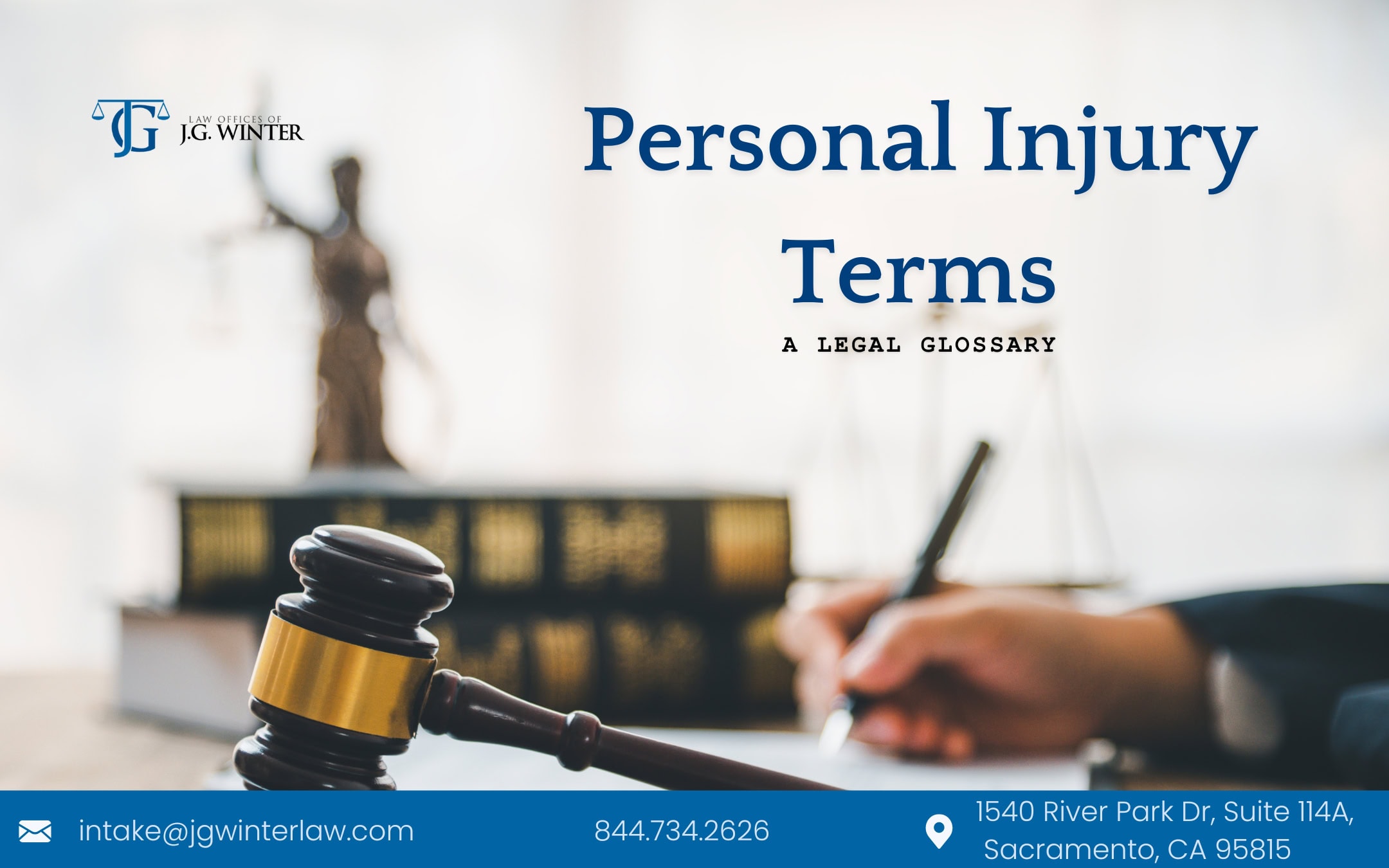Understanding personal injury terms is crucial when navigating the legal complexities surrounding personal injury claims. Familiarity with these terms helps you better communicate with personal injury lawyers and make informed decisions about your case.
JG Winter Law provides clear definitions and practical insights for your justice. We help you navigate personal injury legal terms and secure the compensation you deserve.
Overview of personal injury legal terms
Understanding personal injury legal terms helps you comprehend your rights, and recognize potential compensation options. Legal terminology can include simple definitions like “Accident Report” to more nuanced terms such as “Comparative Negligence.”
A grasp of personal injury terms enhances your ability to provide essential documentation and promotes better decision-making throughout the settlement process.
Legal glossary on personal injury
A strong legal glossary helps build a solid foundation in understanding personal injury cases. You may frequently encounter the following personal injury terms during your case.
A
Ad litem: A legal guardian court appoints to represent individuals unable to advocate for themselves, such as minors or people with mental disabilities.
Accident report: It details an incident, including the involved parties and what happened. It serves as crucial evidence when determining liability in personal injury claims.
Act of god: Unavoidable natural events beyond human control, such as earthquakes or floods. It asserts that the damage was unforeseeable and unavoidable.
Alternative Dispute Resolution (ADR): ADR is a set of strategies for resolving conflicts outside the courtroom, including arbitration and mediation. It is often faster and less expensive than going to trial.
Answer: A formal response a defendant submits to a plaintiff’s complaint. It typically denies or admits allegations and outlines the defendant’s legal defenses.
Appeal: An appeal involves asking a higher court to review a lower court’s decision for potential errors. It aims to change or overturn the original ruling.
Arbitration: Arbitration involves a neutral third-party arbitrator who listens to both sides and renders a legally binding decision.
Assignment of benefits: The transfer of insurance benefits from the insured to another party, like a healthcare provider.
Assumption of risk: A legal defense that argues the plaintiff knowingly exposed themselves to danger. Therefore, the defendant cannot be entirely held accountable for any injuries.
At-fault insurance state: It means the person responsible for the accident must pay for the damages. The victim files a claim with the at-fault party’s insurance company to seek compensation.
Attorney-client privilege: It’s the legal right that keeps communications between a client and their lawyer confidential.
B
Bad drug: A medication that causes unexpected harmful effects due to defects, manufacturing errors, or inadequate warnings. Victims can file claims for injuries caused by these drugs.
Bad faith claim: An accusation against an insurer for not fulfilling its obligations. It could involve delays, denying valid claims, or failing to investigate properly.
Benefit: Refers to financial compensation provided through insurance, government programs, or employers for medical expenses or lost income.
Bench trial: A trial conducted without a jury where the judge makes the final ruling. It’s often chosen to speed up the process or in complex cases requiring technical expertise.
Bodily injury: Physical harm to a person’s body due to accidents or deliberate actions. Compensation aims to cover medical costs, pain, and suffering.
Burden of proof: The responsibility placed on a party to prove their claims in a legal dispute. In civil cases, a preponderance of evidence is required to establish facts.
C
Causation: The connection between the defendant’s actions and the plaintiff’s injuries. It must be proven to win a personal injury case.
Catastrophic injury: Severe injuries causing permanent disabilities, like spinal cord damage or traumatic brain injuries. These can result in significant, long-term medical and care costs.
Claim: A formal request submitted to an insurance company for compensation after an accident or injury.
Claim adjuster: An insurance company employee who investigates the facts of a claim. They determine the liability and the appropriate compensation.
Class-action: A lawsuit filed by a group of individuals against a common defendant. It provides a collective solution to claims affecting many people.
Compensable injury: An injury eligible for compensation according to the terms of an insurance policy or legal guidelines.
Compensatory damages: Financial awards meant to reimburse the plaintiff for actual losses like medical expenses, property damage, and lost wages.
Complaint: A formal document submitted to the court initiating a lawsuit. It outlines the plaintiff’s claims against the defendant.
Compulsory medical examination: An examination required by a court to verify the plaintiff’s injury claims. It helps establish the legitimacy of the injury and the extent of damages.
Concussion: A mild traumatic brain injury caused by a blow to the head. It often leads to confusion, headaches, and nausea.
Contingency fee: A fee arrangement where a lawyer only receives payment if they win the case. Their compensation is typically a percentage of the settlement or verdict.
Contusion: An injury resulting in bruising due to blunt force trauma but without breaking the skin.
D
Deceptive pricing: Advertising a product at a reduced price when the price was artificially inflated earlier, making the discount deceptive.
Deductible: The portion of the claim the insured must pay before their insurance covers the remaining costs.
Defective medication: Drugs that cause unexpected harm due to manufacturing issues, inadequate warnings, or dangerous side effects.
Design defects: Flaws inherent to a product’s design, making it dangerous even if manufactured correctly.
Defendant: The individual or entity sued in a lawsuit. In personal injury cases, they are often the party responsible for the injury.
Demand letter: A formal letter requesting payment or action from the opposing party before legal proceedings begin.
Diminished value: The reduction in a vehicle’s market value after being repaired following an accident.
Deposition: Sworn testimony given by a witness outside the courtroom, used to gather information before a trial.
Disclosure: Revealing or making known information that was previously concealed or unknown.
Discovery: The legal process where parties exchange relevant information before the trial to prepare their cases.
Distracted driving: Operating a vehicle while focusing on activities like texting, eating, or using navigation systems, which can lead to accidents.
Driving Under the Influence (DUI): Operating a vehicle while impaired by alcohol or drugs, posing significant risks to oneself and others.
Duty of care: The legal obligation to act responsibly and avoid causing harm to others. Breaching the duty of care can result in liability for damages.
E
Emergency Medical Condition (EMC): A medical condition that requires immediate attention, where delaying treatment could jeopardize health or lead to serious impairment.
Emotional distress: Psychological suffering resulting from a traumatic incident. It may include anxiety, depression, or sleep disorders.
Excess judgment: A verdict that awards damages higher than the defendant’s insurance policy limits.
Exemplary: Damages meant to punish the wrongdoer rather than compensate the victim, often used synonymously with punitive damages.
Exhaustion of benefits: When the insured party has reached the maximum coverage limits of their insurance policy.
Expert witness: A professional who provides specialized knowledge to help a court understand complex issues related to the case.
F
Fault: Legal responsibility for causing an accident or injury. It determines who should pay for damages.
False advertising: Misleading or deceptive marketing practices that misrepresent a product’s features, price, or origin.
Field adjuster: An insurance representative who inspects damaged property and determines the extent of the insurer’s liability.
First-party claims: Claims an insured individual files against their own insurance provider to cover losses directly.
Force majeure: A contractual clause that removes liability for natural and unavoidable events, like floods or earthquakes.
Full and fair compensation: The total amount of compensation covering all damages and losses suffered by the injured party.
G
General damages: Compensation for non-monetary losses, such as pain and suffering or loss of enjoyment of life.
Gross negligence: Extreme lack of care or reckless disregard for the safety of others beyond ordinary negligence.
Good faith: The obligation to act honestly and fairly in contractual relationships, especially in insurance matters.
H
Hazard: A condition or circumstance that increases the risk of an accident or injury.
Health care expenses: Costs related to medical treatment, including doctor visits, hospital stays, and medications.
HIPAA act: The Health Insurance Portability and Accountability Act is a federal law protecting patient health information privacy.
I
Income Replacement Benefits (IRBs): Financial support provided to accident victims who cannot work due to injuries, covering a portion of their lost wages.
Independent medical examination: A medical assessment conducted by a doctor not previously involved in a patient’s care, often requested by insurance companies.
Insurance: A contract where one party (insurer) agrees to compensate the other (insured) for specific losses in exchange for regular premium payments.
Insurer: The company that provides insurance coverage to individuals or organizations.
Insured: The person or entity covered by an insurance policy. It is entitled to receive compensation in case of covered losses.
Intentional wrongs: Deliberate actions that cause harm to others, often leading to personal injury claims (e.g., assault or defamation).
Interrogatories: Written questions exchanged between parties in a lawsuit, intended to gather detailed information about the case.
J
Judgment: A formal decision the court makes. It determines the rights and obligations of parties in a lawsuit.
Jury instructions: Guidelines a judge gives to the jury explaining the legal standards they must apply when deciding a case.
K
Known loss rule: An insurance principle that denies coverage for losses known to the insured before obtaining the policy.
L
Lemon law: Consumer protection laws that offer remedies to car buyers whose vehicles repeatedly fail to meet quality standards.
Letter of protection: A letter ensuring that a healthcare provider will be paid for their services from a personal injury settlement or verdict.
Liability: Legal responsibility for causing harm, which may require compensation to the injured party.
Limitation of risk: Clauses in contracts that limit a party’s liability to certain conditions or a maximum amount.
Litigant: A person or entity involved in a lawsuit, whether as a plaintiff or defendant.
Litigation: The process of taking a case through the court system to resolve a legal dispute.
Litigation risk: The potential for loss or adverse outcomes when a case goes to court.
Loss: Any financial, physical, or emotional harm suffered by an individual due to another’s negligence or wrongful act.
Loss of earnings: Income that an injured person cannot earn because of their accident-related impairments.
M
Malice: The intentional act of harming another person without legal justification, often with ill intent or disregard for their safety.
Malpractice: Professional negligence by a licensed professional (such as a doctor) that results in injury or loss to the client or patient.
Mandate: A court or administrative order requiring a party to perform a specific action.
Maximum Medical Improvement (MMI): The point at which an injured person’s condition is not expected to improve further with treatment.
Mediation: An alternative dispute resolution process where a neutral third party helps the disputing parties settle.
Medical malpractice: Negligence or improper treatment by a healthcare professional that causes harm to a patient.
Mesothelioma: A rare form of cancer often linked to asbestos exposure, leading to potential personal injury claims.
Motion: A formal request made to a court asking for a specific ruling or order in a case.
N
Negligence: Failure to exercise reasonable care, leading to harm or injury to another person.
Negotiation: Discussions between parties or their representatives to reach an agreement or settlement.
No-fault: An insurance system where each party’s insurer compensates them regardless of who was at fault.
No-fault insurance state: A state that requires drivers to carry insurance to cover their own injuries in an accident, regardless of fault.
Notary: An authorized individual who witnesses the signing of documents and verifies their authenticity.
Notice to the company or Insurer: A formal notification sent to an insurance company to inform them of an incident, claim, or lawsuit.
O
Occupational diseases: Illnesses caused by exposure to harmful substances or conditions in the workplace.
One-bite rule: A legal principle stating that an owner can only be held liable for an animal bite if they knew the animal was dangerous.
Opening statement: An attorney’s initial remarks to the jury, outlining the case and evidence they intend to present.
Ordinary negligence: A failure to exercise reasonable care, resulting in accidental harm to others.
Out-of-court settlement: An agreement reached by the parties to resolve a dispute without going to trial.
Out-of-pocket expenses: Costs directly paid by an individual due to an injury, not covered by insurance.
P
Pain and suffering: Physical and emotional distress caused by an injury, often included in personal injury claims.
Paralegal: A trained legal assistant who supports lawyers by conducting research, drafting documents, and managing cases.
Parties: Individuals or entities directly involved in a legal case as plaintiffs or defendants.
Pecuniary damages: Monetary compensation for financial losses resulting from an injury.
Personal injury protection: Insurance coverage that pays for medical expenses and lost wages after an accident, regardless of fault.
Plaintiff: The party who initiates a lawsuit by filing a complaint against another party (the defendant).
Pleading: Written statements submitted by each party in a lawsuit outlining their claims or defenses.
Post-concussion Syndrome (PCS): A condition where symptoms like headaches and dizziness persist for weeks or months after a concussion.
Post-traumatic Stress Disorder (PTSD): A mental health condition triggered by experiencing or witnessing a traumatic event.
Prayer for relief: The section of a legal complaint where the plaintiff specifies the compensation or remedy sought.
Precedent: A legal decision from an earlier case that serves as a guideline for future cases with similar circumstances.
Premises injury: An injury that occurs on another’s property due to unsafe or hazardous conditions.
Premises liability: Legal responsibility of property owners for injuries sustained on their premises.
Proceeding: A formal action taken in a court or administrative agency to resolve a dispute.
Product liability: Legal responsibility of manufacturers or sellers for harm caused by defective products.
Prognosis: A medical professional’s forecast of the likely outcome or recovery of an illness or injury.
Proximate cause: The primary cause that directly leads to an injury, without which the harm would not have occurred.
Q
Quality of life: A measure of a person’s overall well-being, considering factors like health, comfort, and happiness.
Qui tam: A legal action where a private individual can sue on behalf of the government and receive a portion of the recovered damages.
Quid Pro Quo: A Latin term meaning “something for something.” It describes an exchange where one favor or advantage is granted in return for another.
R
Reasonable care: The level of caution and concern an ordinary person would use in similar circumstances to prevent harm.
Recklessness: Behavior showing a conscious disregard for safety and the potential to cause injury.
Rehabilitation: Medical treatment and therapy to restore physical function or improve quality of life after injury.
Rehabilitation benefits: Financial support for medical treatment and therapy to help an injured person regain function.
Respondeat superior: A legal doctrine holding employers liable for the actions of their employees.
Request: A formal or informal appeal or inquiry submitted to a person or organization.
S
Settlement: An agreement between parties to resolve a legal dispute without going to trial.
Sexual assault: Any non-consensual sexual contact or behavior.
Slip-and-fall: An injury occurring when a person slips, trips, or falls on someone else’s property due to unsafe conditions.
Special damages: Compensation covering quantifiable losses, such as medical expenses or lost wages.
Stacking of coverages: Combining multiple insurance policies or limits to maximize compensation for an injury.
Standard of care: The level of care an ordinary, reasonable person would exercise in similar circumstances.
Statute of limitations: The legal deadline within which a lawsuit must be filed.
Statute of repose: A law limiting the time after an event within which a claim can be filed, regardless of when the injury is discovered.
Strict liability: Holding a defendant liable for an injury regardless of negligence or intent, typically in product liability cases.
Subpoenas: Legal documents ordering a person to appear in court or produce evidence.
Subrogation: The right of an insurance company to pursue a third party that caused an insurance loss to the insured.
Survival claim: A claim filed on behalf of a deceased person’s estate for damages the deceased could have recovered if they had lived.
T
Third-party claims: Claims filed against someone other than the claimant or their insurance company, often against another driver in car accidents.
Tort: A wrongful act causing injury or harm to another person, leading to civil legal liability.
Traumatic Brain Injury (TBI): A brain injury resulting from a sudden impact or trauma.
Trier of facts: The person or group (judge or jury) responsible for evaluating evidence and making factual determinations in a trial.
U
Unconscionable act: An action so unfair or unjust that it shocks the conscience.
Underinsured Motorist Coverage (UM): Insurance coverage that compensates an injured person when the at-fault driver’s insurance is insufficient.
Uninsured Motorist Coverage (UIM): Insurance covering injuries and damages when the at-fault driver lacks insurance.
V
Verdict: The decision a judge or jury makes at the end of a trial.
Voir dire: The process of questioning potential jurors to determine their suitability for a case.
W
Workers’ compensation: Insurance providing benefits to employees injured or disabled in the course of their employment.
Wrongful death: A death caused by the negligent or wrongful actions of another, leading to a civil lawsuit.
Legal representation and contingency fees
A personal injury can help you navigate the complexities of legal claims and negotiate fair compensation. Contingency fees make legal assistance accessible as you pay a percentage of your settlement only if you win the case. A personal injury lawyer:
- Identifies viable claims and calculates damages.
- Gathers crucial documentation and witness statements.
- Advocates for a fair settlement with insurance companies.
- Handles paperwork, court appearances, and negotiations.
Conclusion

You must understand the terms of personal injury to know your rights and secure fair compensation. It enables you to better communicate with your attorney and understand the legal process. J.G. Winter helps you receive the guidance and support needed to navigate your claim. Contact us today for experienced assistance and reliable legal advice.
FAQs on personal injury terms
What is an injury in legal terms?
In legal terms, an injury refers to any harm or damage inflicted upon one’s body, mind, emotions, or property due to another party’s negligence, recklessness, or intentional actions. It forms the basis for seeking compensation.
What is the term used for personal injury?
The term used for personal injury is “tort.” A tort is a civil wrong that occurs when someone’s actions or negligence cause harm or injury to another person. This harm can be physical, emotional, or financial, and the injured party may seek compensation through the legal system.
What term in civil law refers to personal injuries?
The term “tort” is used in civil law to describe wrongful acts that result in personal injuries or damages, leading to a legal liability. Torts encompass negligence, intentional acts, and strict liability claims.
What is a contingency fee in personal injury law?
A contingency fee is a payment arrangement where the lawyer only receives payment if they win the case or negotiate a favorable settlement. Typically, the fee is a percentage of the settlement amount.
What is a statute of limitations for personal injury claims?
A statute of limitations is the time limit within which a plaintiff must file a personal injury lawsuit. It varies by jurisdiction and type of injury but is generally between one and three years.
What is the difference between a settlement and a trial verdict?
A settlement is a mutual agreement between parties, often outside the courtroom while a trial verdict is a final judgment a judge or jury makes after hearing the evidence in a courtroom.


